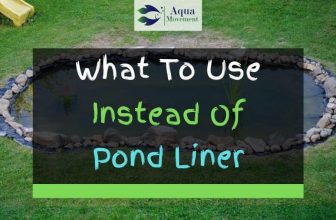8 Common Types Of Pond Turtles (With Pictures)
Turtles can make an amazing addition to any pond. Firstly, they are beneficial for the ecosystem at large. As large animals and consumers, their waste and general activity can become nutrients and feed for other creatures in and around your pond.
They can also help to oxygenate stagnant water by moving around, and they may attract other exciting species to the pond. There are of course more aesthetic reasons to invest in pond turtles as well. They can add to the harmony and feel of your pond.
Young guests in particular will be awestruck by the sight of the small turtles lumbering slowly around on land, or swimming nimbly in the pond. If you are looking for a sure-fire way to elevate your pond to the next level, then pond turtles may be the way to do it.
Of course, as with the introduction of any other species to your pond, you need to think long and hard before you bring in any turtles. Each species has their own specific peculiarities, requirements, pros and cons.
In this exhaustive list we will introduce some of the most popular types of pond turtles for domestic situations, and you should make a responsible choice based on this.
Table of Contents
Background
Some people get confused between tortoises and turtles. They are all reptiles who belong to a similar family, and unfortunately, though not strictly correct, the names are often used interchangeably. In fact, there are a couple of relevant groups.
Turtles are shelled creatures who are mostly aquatic, meaning they spend most of their time in the water, and as a result they have webbed feet to help them get around. On the other hand, tortoises are mostly land based creatures, only rarely heading into shallow water.
They can be identified by their short stubby legs and characteristically slow means of getting around. Some of the gigantic creatures found in the Galapagos islands are actually tortoises, not turtles.
There is also a third group of related creatures, known as terrapins, which are essentially a hybrid of the two.
Even with in the ‘turtles’ category there is a huge amount of diversity. There may be more than 300 distinct species of turtle in the world, and experts have not settled on a final number. Turtles can be either aquatic or semi-aquatic.
Fully aquatic turtles spend almost all of their time in the water, including sleeping and hibernating in the water. They may only venture onto dry land to lay their eggs. Semi-aquatic turtles are more comfortable on terra firma and may spend half their life on land, and half in the water.
This is not the only distinction you will find among the different types of pond turtles. You also need to consider what type of water they are suited to (brackish or freshwater), what water conditions are native to them and what climate they prefer.
All these contrasts should inform your choice of pond turtle and will be considered in the comprehensive list below.
Painted Turtle
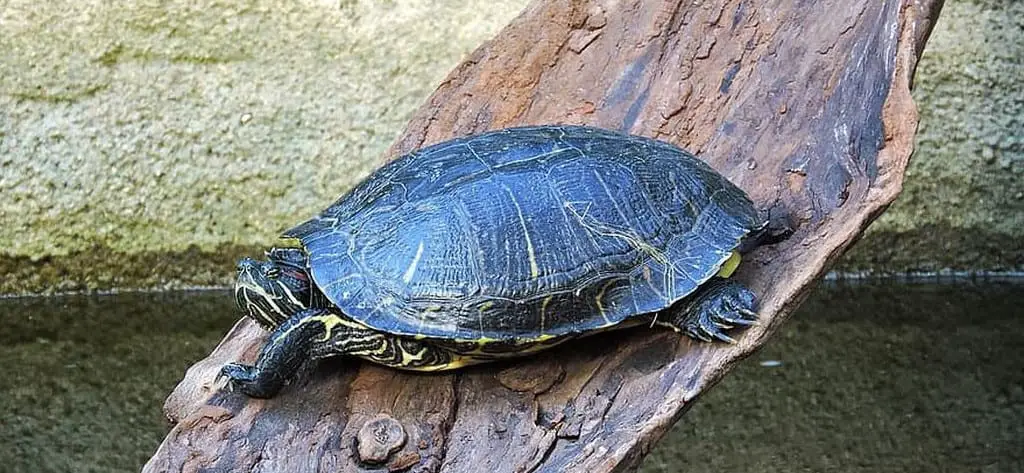
There is a lot to like about this species. It is one of the most popular breeds in the US. This is partly because of its attractive patterned shell, but it is also extremely easy to take care of.
If you just feed this regularly with food that is high in minerals and nutrients, then this pet will happily take care of itself and live for many long years.
It is a fairly inactive species, mainly being dependent on the ambient heat to get enough energy to move about. This means it is only active in the hottest parts of the day and will stay pretty still otherwise.
It usually hibernates during the coldest months of the year, preferring to shelter in the mud at the bottom of ponds. This means it is most suited to warmer climates, and if your pond is in danger of freezing over in the winter then you need to be especially careful.
It grows to between 5 and 7 inches in length, and will grow steadily from birth until sexual maturity, which occurs when the turtles are between 6 and 16 years old.
This species is found in the wild in North America, so there are no regulations surrounding its domestication there.
However, in areas where it is not native pet owners should consult local requirements and must always make sure that their turtle cannot escape into the wild, as it could become a damaging invasive species.
Red Eared Slider
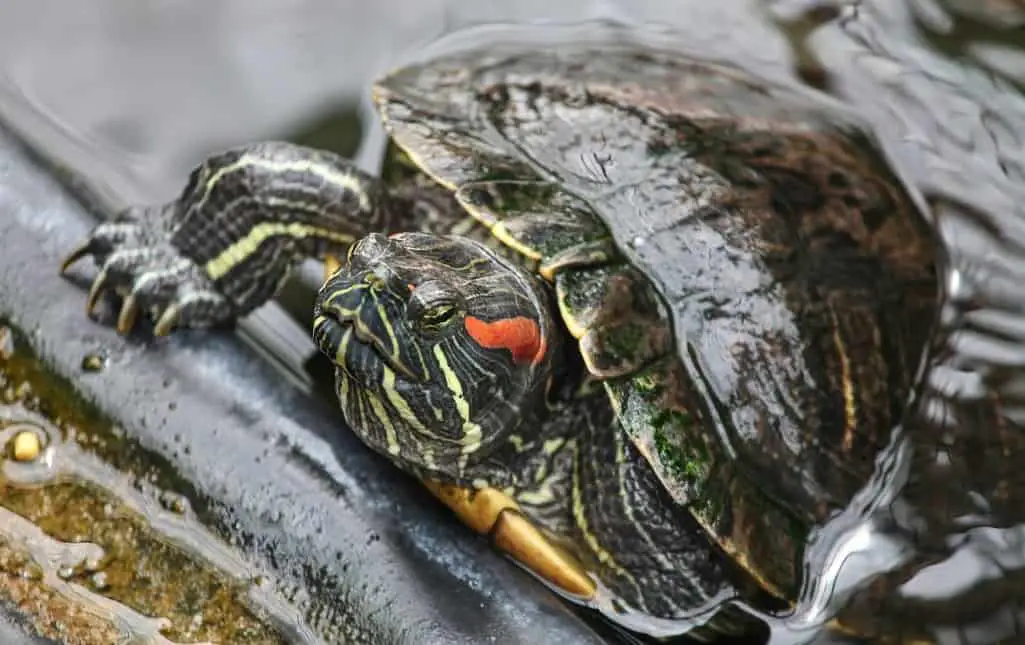
This is the most commonly sold turtle in the world, and there are some very good reasons for this resilient popularity. It is a small pond turtle that will be perfect for the small ecosystem of a backyard pond.
They are usually available as juveniles which are only a few inches in size, but you should be aware that when they are fully grown, they can be to a foot long. One of the most attractive features of this aquatic turtle is the range and depth of colors present.
It is named for the patches of red on the sides of its head, and the rest of its body and hard shell is a deep, beguiling green.
This turtle is most suited to warm climates. They prefer a water temperature above 29 C, and the ambient air temperature should be above 28 C for them to feel most at home.
They can be raised in large indoor tanks if you can’t provide these kinds of warm conditions, but your tank must be large, well aerated and suitably cycled.
Therese terrapins love to be mobile and will regularly go from land to water and vice-versa. Because of this you need to provide at least one easy entry and exit point to your pond, so your turtles can easily find their way around.
Box Turtles
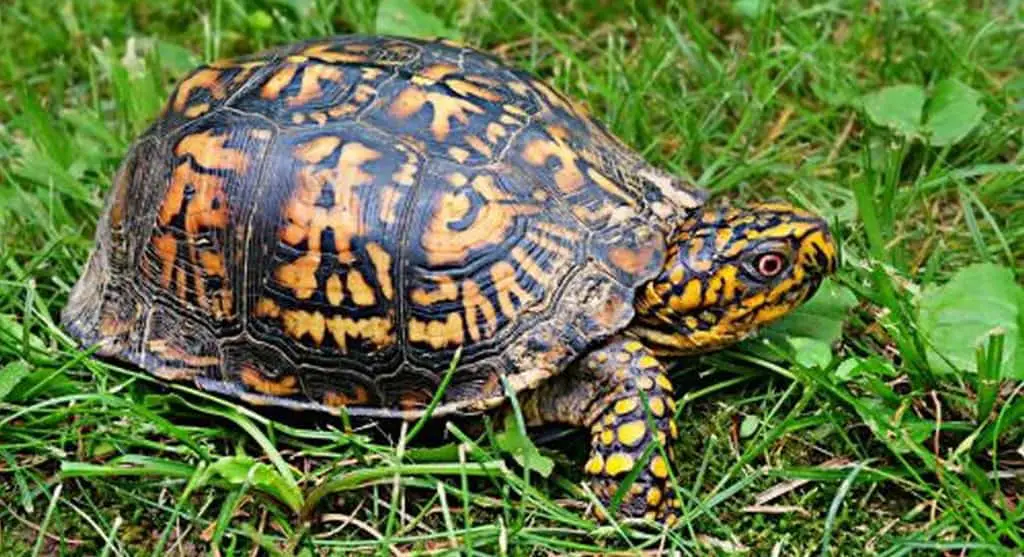
Unlike the other two types of pond turtles described above, the box turtle is actually a common name for a group of four separate sub-species.
It is almost a mixture of both turtles and tortoises, and it is characterized by its peaked dome shell and tough, scaly skin. Subspecies include the Mexican, Gulf Coast and Common Eastern box turtle.
Box turtles are not as well adapted for domesticated pet life as the other types we have already mentioned. They have a low reproduction rate which makes breeding these animals difficult, and their populations in the wild are already in decline because of this and the major loss of habitat due to human activity.
As well as they do not enjoy being touched or handled and can become stressed out over alarmingly small things. Loud noises or unfamiliar surroundings are likely to cause mood swings which can negatively affect their general health and wellbeing.
If you are intending to keep these creatures make sure your pond is calm and free from any startling disturbances.
Box turtles are omnivores that will eat a variety of slugs, insects, plants and berries. Feeding these creatures should not be a major issue. They usually grow to be between 4-8 inches in length, and occasionally their shells feature extensive yellow markings.
This is one of the reasons why people continue keeping these sometimes-troublesome creatures as pets.
Yellow-Bellied Slider
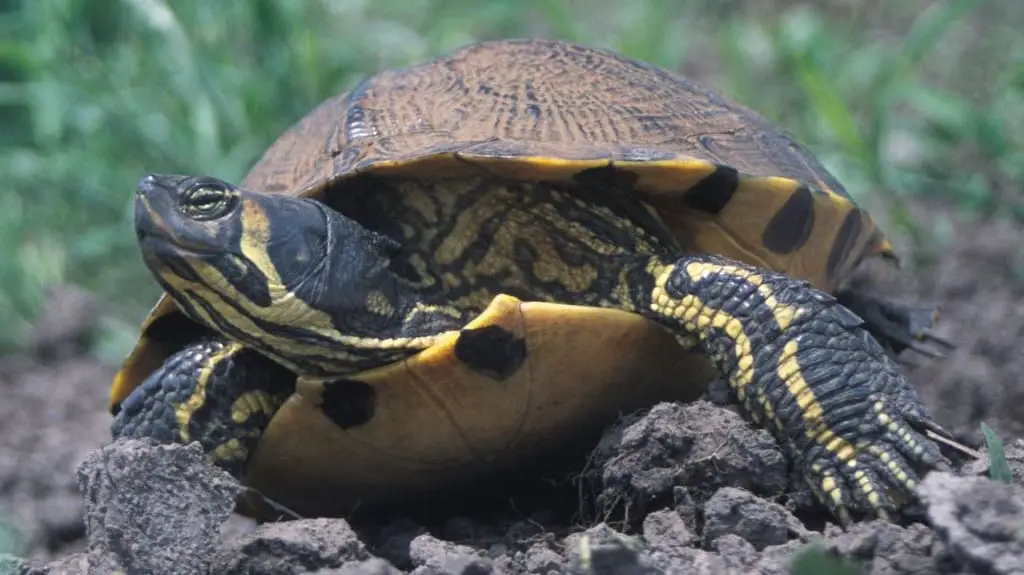
You may notice some striking similarities between this common breed of turtle and the red-eared slider that we outlined earlier. It too is a slider turtle, with a similar anatomy, general body shape and size.
It too will grow to about 8 inches in size, once it reaches full adulthood. It also has a similar diet, so many of the commercial products you find that are targeted for red-eared sliders will be equally applicable with their yellow-bellied cousins.
This is one of the most attractive breeds of turtle on the market. It is notable for the deep yellow streaks that run from its head, down along its neck and to the underside of the turtle. The yellow bands are interspersed with black dots.
It is a semi-aquatic turtle that will spend a lot of its time basking in shallow water, preferring that to swimming. You should take this into account when planning your pond, and also make allowance for easy entrance and egress.
Like most turtles this is an omnivorous creature, but it has a particular predilection for meat. In fact, in the wild about 90% of its diet comes from insects, frogs and other animals. You should try and replicate this natural feeding pattern as much as possible in captivity.
It is a long-lived creature so you should be prepared to take care of it for the long haul. Some have been known to live for over 40 years in captivity.
Western Painted Turtle

If you really want to introduce a bit of glamour and style to your pond, then you should consider bringing in one of these creatures. The Western painted turtle is not particularly large, growing up to 10 inches maximum, but it is a very attractive creature.
Their skin features light colored lines on a dark background and their shell is famous for its intricate and elaborate markings.
These are among the friendlier turtles to keep as pets. Unlike some other species they enjoy frequent handling and may even form a positive bond with their owner. If you treat them properly and look after their needs then they could survive for up to 50 years in a garden pond setting.
They should be given plenty of space to roam, and the water should be adequately filtered and oxygenated. Too many turtles in a confined space can lead to over-competition for resources and depletion of resources in the area.
If you are unsure about what kind of requirements it has just look at the information for red-eared sliders, as they have very similar needs.
This sub-species of the aforementioned painted turtle is actually native to regions in Canada such as British Columbia, so it can tolerate much cooler conditions than many of the other species featured here. This might make it suitable for export to less sun-kissed countries such as the U.K.
Musk Turtle

This is among the more interesting types of pond turtles that you can buy anywhere in the world. It is so named because it can produce a potent odor to ward off any predators that are threatening it, much like the skunk.
In fact, it is also known as the stinkpot! But in everyday life you don’t have to worry about the smell being an issue!
The musk pot turtle is most suited to shallow water bodies and it loves to dwell in muddy, mucky areas. It can also thrive in sandy soils, but it prefers to spend most of its time in the water. It is distributed over a huge region in the wild, being found everywhere from the Southern parts of Canada to the Eastern reaches of the United States.
This means it is a rough and resilient little creature which is able to tolerate great changes in climate, ecosystems and water conditions.
The common musk turtle is usually grey, black or brown and it has a domed shell. It can grow up to 5 inches in size and usually weights just over a pound.
Females are typically larger than males, but the male is distinguished by a longer protruding tail. It is almost entirely aquatic, typically only venturing onto land to nest and lay eggs. This means that as a pond owner you don’t need to provide a lot of land beside your pond for them to explore.
It is highly carnivorous and should not be fed solely on turtle pellets, as this may lead to vitamin deficiencies. In the wild it eats mostly fish and shrimp, so these can be used to supplement normal turtle diets.
This is one of the smallest species of turtle featured on this list, which may make it more attractive as a pet in a lot of cases. However, if you are looking for a creature to admire all the time, this may not be it as it is a bottom-dweller which spends most of its time lurking at the bottom of the water.
African Sidenecked Turtle/ (African Helmeted Turtle)

Most of the types of pond turtles featured here are native to North America, but, as the name suggests, this turtle is native to Africa. Specifically, this turtle is found in the wild all-over large swathes of Eastern and Southern Africa.
These turtles can grow to quite large sizes, between 8 and 18 inches. This size, coupled with a dominant personality, can sometimes make them a bit aggressive when kept with other, smaller, turtles.
This is usually not a problem if they are just kept with other members of the same species. They can make great pets because they are naturally curious and gregarious animals, meaning that they will happily interact with humans and not shy away from busier gardens.
Their name comes from the fact that they cannot fully retract their heads into their shells like most other turtles. Instead, to adopt a defensive position, they will pull their neck back as far as possible and lie down on their side.
They are true sun-worshippers, liking to spend a long time out of the water basking in the sun. Thus, if you want to provide a nice habitat for these turtles make sure there are plenty of good sun-traps near the pond for them to relax in.
They are only suitable for warm climates where the water temperature never falls below 70 F. If winter conditions prove troublesome then you could move them into a warmer area indoors, because they will not naturally hibernate.
Common Map Turtle/ (Northern Map Turtle)
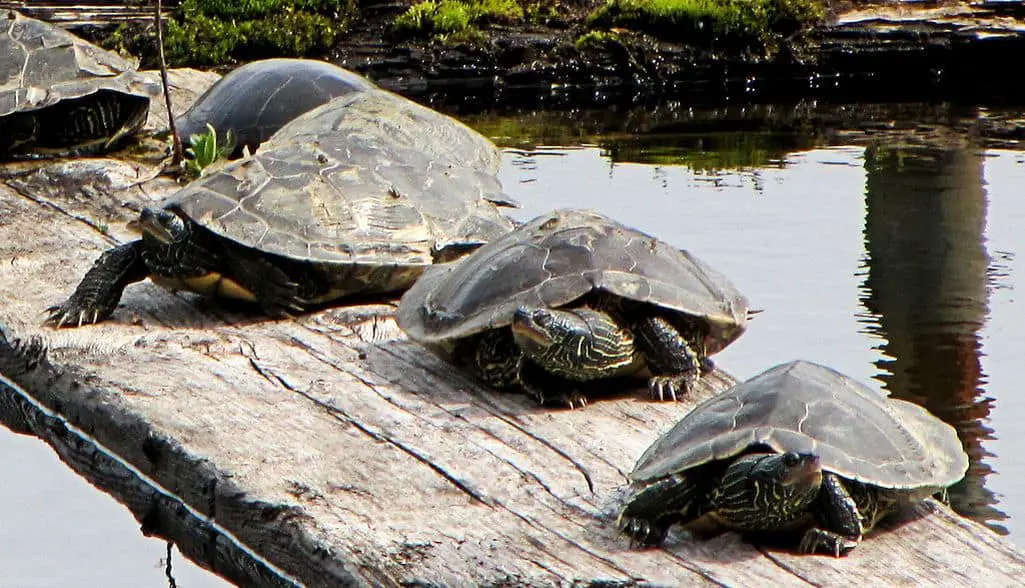
This is one of the most popular types of pond turtles that is widely found in pet stores. Map turtles comprise a number of different breeds, but the common map is the most numerous being found as far north as Quebec and as far south as Alabama.
They vary a lot in size, being between 6 and 10 inches long. Generally, females are twice as big as their male counterparts.
Their skin is generally olive green with faint yellow markings, and their shells can be very pretty due to faint yellow lines that can resemble an ordinance survey map (hence their name). Unfortunately, sometimes these lines are obscured due to mud or algae.
In the wild they generally prefer large bodies of water such as rivers and lakes, but most domesticated creatures will easily adapt to pond conditions.
This type of turtle may be more suited to experienced owners than novices. They can be quite delicate and require very high-quality water. Any slight disturbance in terms of pH or nutrient level can damage their sensitive constitution.
They are notably susceptible to bacterial infections and shell rot if you are not careful. They prefer moving water, so in a pond you will most likely need to install a strong aerator or a waterfall of some sort to provide natural circulation.
Their feeding habits will change as they age. Juveniles prefer plant matter-based food while adults need more protein in their diet so they will need a more carnivorous supply of food. If you feel up to the challenge of keeping a more demanding species, then this could be the pet for you.
Keeping Pond Turtles
Video: “Pros and Cons of Keeping Turtles Outdoors”
No matter which of the many types of pond turtles you decide to keep, there are a few core considerations you need to take into account. Firstly, if possible, you should keep turtles that are native to your area.
This is better for the local wildlife and ecosystem as the species is already integrated and compatible with the environment. You don’t need to worry about whether or not the climate will be suitable, or if natural predators are going to be an issue.
What’s more, if your pet escapes then it is not as much of a problem. If a non-native turtle escapes, then it could be considered an invasive species and this could have very negative long-term effects if they start to breed in the wild.
Take into account your turtle’s space requirements as well. Some turtle breeds need a large amount of accessible dry land to bask in, while other creatures need very little. Similarly, some turtles need very little room to swim around in, while others require a larger pond.
This is primarily based on the size of the turtle, but this is not the only factor.
Don’t overlook the depth of your pond either. While some species (mainly keen swimmers and bottom-dwellers) love a deep pool, others feel more at home in shallow water where they can walk around and still feel the heat of the sun. You might need a mix of both.
Other practicalities become important too. For example, give some thought to how your turtles are going to get into and out of the pond. You will need some section with a shallow slope to allow them to easily enter and exit the pond.
Finally, make do some research into the exact diet that your turtle requires. Generic turtle pellets will suit a lot of species, but some breeds may have special requirements in terms of vitamins, minerals and nutrients.
Conclusion
Turtles could make a great addition to any pond, so long as you have the correct resources and set up in place to accommodate them. There are so many types of pond turtles to choose from, but we have tried to describe the most popular variants worldwide.
Whether you want the large and domineering red-eared slider, or the more petite musk turtle, you should make sure that you are capable of taking care of these creatures. Some of them are very aesthetically pleasing, whilst others have charming, friendly personalities. It is up to you what traits and features you want to prioritize.
Turtles and ponds go together like ice cream and jelly. So, if you want to brighten up your tired old pond then make sure to pick a suitable breed from our list of the most popular pond turtle breeds.
What Do Pond Turtles Eat? – A Feeding Guide


